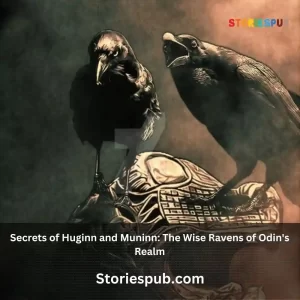Skadi – Norse Goddess of Winter Sports and Hunting

The Legendary Skadi: A Norse Goddess of Winter, Skiing, and Hunting
Skadi is a Norse goddess who is often overlooked compared to other gods and goddesses of the pantheon. Yet, her importance in Norse mythology cannot be ignored as she is the goddess of winter, skiing, and hunting.
Her stories are just as fascinating as any other god’s in the Norse pantheon. In this article, we will explore Skadi’s background, her domain, and her legacy.
Introducing Skadi
Skadi is known as one of the most important deities in Norse mythology. She was considered a powerful huntress who ruled over winter’s domains with an iron grip.
Her name has been derived from the Old Norse word ‘skíð’ which means skis or sleds. She was also associated with skiing and snowshoeing – activities that were essential for hunting during winter.
Despite being an important goddess in ancient times, Skadi is often overshadowed by more well-known Asgardian gods such as Thor or Odin. However, according to legend, she played a vital role in shaping the world we know today.
Skadi’s Background
According to ancient tales passed down through generations of Nordic cultures, Skadi was born into a family of giants; specifically Thiazi or Thjazi was her father. He was known for his infamously large size and strength as well as his powerful magic abilities.
After Thjazi’s death at the hands of Loki (who had tricked him), Skadi sought revenge on behalf of her father by attacking the gods in Asgard with her arrows. But Odin proposed that instead of taking up arms against them all she should be given a chance to pick a single husband from among them; blinded by rage towards Loki she agreed without knowing anything about their looks etc.
Skadi’s Domain
As the goddess of winter and skiing, Skadi was associated with ice and snow, she often resided in high mountain ranges where the snow never melted. She was also considered an expert in hunting, using her skills to track prey through the harshest conditions.
In Norse mythology, Skadi is said to have the ability to control and bring forth winter elements like blizzards, frostbite or avalanches. It was believed that after seeking revenge for her father’s death, she made a deal with Odin where he allowed her powers to bring forth cold weather if she married one of them.
The Great Hunt
One of Skadi’s most well-known tales is that of The Great Hunt, which ultimately led to her marriage with Njord. In this tale, Skadi challenged the gods of Asgard to a grand hunt in exchange for choosing a husband from among them.
She put herself up against them as an equal; it would be just like any other competition where they got their chance while she called upon all her skills as a hunter who had honed them over years spent tracking game across difficult terrain. Ultimately though Njord proved himself victorious despite being outmatched by his competitors due mostly due him being more refined than anyone else present.
Skiing Competition
Another story that speaks volumes about Skadi’s prowess as a hunter and skilled skiier is when she challenged Ullr (the god of archery and skiing) to a skiing competition. Ullr was considered one of Asgard’s greatest hunters at that time; it wasn’t easy for him to accept defeat from anyone especially not someone who could keep up with him on skis! In this story too she showed off how good she was at skiing by winning against someone who had been widely regarded previously unbeatable just because people had never seen Skadi’s skiing skills before.
Legacy
Despite not being as well-known as some of the other Norse gods, Skadi holds a special place in Norse mythology. Her stories showcase her strength, skill, and determination; she is a strong female figure who was known for being a skilled huntress and expert skier.
In fact, many winter sports enthusiasts today still honor her legacy by participating in ski races and winter hunting activities. Skadi’s stories reveal her to be an important goddess of winter whose domain extended over icy mountains and snow-covered valleys.
Her reputation as a formidable huntress resonates even today with many modern-day hunters who look up to her powerful character as an inspiration. We hope that this article has given you some insight into the legendary Skadi and her impact on Norse mythology.
Skadi’s Background
The Daughter of Thjazi
Skadi was the daughter of the giant Thjazi, who was known for his strength and cunning. According to Norse mythology, Thjazi once captured the god Loki and demanded that he bring him the goddess Idun, who was responsible for keeping the gods young by providing them with apples from her orchard.
Loki tricked Idun into leaving Asgard, the home of the gods, and led her into Thjazi’s clutches. The gods were unable to remain young without Idun’s apples, so they set out to rescue her.
During their quest, they called upon Skadi for assistance as she was known for her skills in hunting and tracking. Skadi agreed to help them on one condition: that one of the gods would marry her.
Marriage and Revenge
The gods agreed to Skadi’s terms and promised her that she could choose a husband based on nothing more than his feet. When it came time for Skadi to make her choice, she selected what she believed to be Baldr’s beautiful feet but instead chose Njordr by mistake. Njordr was a god of fertility associated with wealth, fishing, and sailing – not exactly a match made in heaven with Skadi who preferred colder climates and hunting over sailing or fishing.
Nonetheless, they were married. Soon after their marriage started experiencing hardships due to their differences.
Njordr longed for his former life near water while Skadi yearned for snow-covered mountains where she could hunt freely as before. To seek revenge against those responsible for her father’s death – Odin Thor – Skadi divorced Njordr soon after their marriage consummation.
Conclusion
Despite being an important figure in Norse mythology due to her association with winter sports like skiing, hunting, and even ice skating, Skadi is often overlooked compared to other gods and goddesses. However, her backstory as the daughter of Thjazi who sought revenge for her father’s death by marrying one of the gods is an important part of Norse mythology. It highlights the strength and determination that Skadi embodies – a force to be reckoned with even among the mightiest of gods.
Skadi’s Domain
Winter’s Warrior: How Skadi is Associated with Winter
Skadi is often referred to as the goddess of winter, and for good reason. In Norse mythology, she was responsible for bringing snow and cold weather to the world.
She would often travel through the mountains during winter, hunting wild game and making sure that winter was in full force throughout her domain. Skadi was known to be a fierce warrior, and her association with winter only added to her fearsome reputation.
The Thrill of the Hunt: Skadi’s Love for Hunting
Not only was Skadi associated with winter, but she was also known as a skilled hunter. It is said that she inherited this trait from her father, Thjazi, who was also an accomplished hunter before his death.
Skadi loved nothing more than tracking prey through the snow-covered mountains of her domain. She often hunted alone or with a small group of trusted companions.
The Art of Skiing: Skadi’s Connection to Skiing
Another aspect of Skadi’s domain was skiing. As the goddess of winter, it can be assumed that she had knowledge of how to traverse snowy terrain on skis.
In fact, there is a story in Norse mythology where Skadi challenged another god to a skiing competition. She won by using her skills as a hunter and understanding how to navigate treacherous terrain.
Bringer of Snow and Cold Weather: Skadi’s Role in Nature
Skadi played an important role in nature by bringing snow and cold weather during the winter months. This not only provided necessary moisture for plants but also helped control populations of certain insects and animals that were detrimental to crops or other plant life during warmer months.
The Lesser-Known Goddess: Why Skadi is Overlooked
Despite Skadi’s important role in Norse mythology, she is often overlooked compared to other gods and goddesses. This may be due to the fact that her domain is limited to winter, skiing, and hunting.
Additionally, Skadi did not have many myths or stories written about her compared to other figures in Norse mythology. However, her importance cannot be denied as she played a crucial role in controlling the climate and maintaining balance in nature.
Skadi may not be as well-known as some other gods and goddesses in Norse mythology, but her association with winter, skiing, and hunting make her a unique figure. Her role in bringing snow and cold weather to the world helped maintain balance in nature while also adding to her fearsome reputation as a warrior goddess.
The Great Hunt
One of the most significant stories about Skadi is the great hunt she challenged the gods to in exchange for choosing a husband from among them. The hunt was a competition between Skadi and the gods, and it lasted for several days.
The aim of the hunt was to see who was the best hunter among them. Whoever won would have Skadi’s hand in marriage.
The gods were worried about losing to Skadi, but they also knew that they couldn’t let her win. They had to maintain their reputation as the mightiest beings in all of creation.
So they set out on the hunt with great determination, but despite their best efforts, Skadi emerged victorious. As promised, Skadi chose her husband from among the gods.
Ultimately she chose Njord, a god associated with wind and sea. However, their marriage did not last long due to their differing lifestyles.
Skadi Chooses Njord
Skadi initially chose Njord because he had beautiful feet that reminded her of Balder’s feet. Balder was another god who had already died before this event took place. Unfortunately, after their union, it became clear that they had very different lifestyles and habits.
For example, Njord loved living near water bodies where he could hear waves crashing against rocks all day long while hunting on occasion as his duties allowed him to indulge himself into sea activities whereas Skadi loved living high up in icy mountains where snow never melted holding archery tournaments against other Gods since she was inclined towards hunting more than anything else.. This made it hard for them to live together harmoniously. Eventually, they decided that it would be better if they parted ways.
Njord’s Departure
Njord eventually left Skadi and returned to his home by the sea. It was a sad moment for both of them, but they knew that it was for the best. Skadi went back to her life in the mountains, while Njord continued his duties as a god of wind and sea.
In Norse mythology, this tale serves as a warning about the importance of choosing a spouse who shares similar values and lifestyle habits. It is also indicative of how difficult it can be to make such choices when there are so many different options available.
Conclusion
Skadi’s great hunt story is an important one in Norse mythology. It highlights her skills as a hunter and establishes her as one of the most powerful beings in all of creation.
Her choice to marry Njord despite their differences also shows us that even gods have difficulty finding true compatibility. The story has been passed down through generations and continues to be an important part of Norse mythology today, reminding us about the complexities of relationships and how they can be influenced by external factors such as lifestyle differences.
Skiing Competition
The Challenge
Skadi’s love for skiing was well-known among the gods, and she was infamous for her impressive skills on the slopes. One day, she found herself challenging another god to a skiing competition. This god was known for being quick on their feet and skilled with a bow, but Skadi was determined to prove that her hunting skills made her unbeatable on the slopes.
The Race
The race took place high in the mountains of Asgard. Skadi and her opponent stood at the top of a steep incline, ready to race down the mountain at break-neck speeds. The course was treacherous, with sharp turns and icy patches that would send any lesser skier tumbling down the slope.
As soon as the starting signal sounded, Skadi pushed off from the top of the mountain with incredible strength and agility. She weaved through obstacles that would have tripped up anyone else, using her hunting instincts to anticipate every twist and turn in the course ahead.
Her opponent was fast but not quite as agile as Skadi on this treacherous slope. They tried to catch up by using their bow to shoot through some obstacles but it only slowed them down.
The Finish Line
Skadi flew across the finish line first in record time – many minutes ahead of her opponent – leaving everyone who had gathered at the bottom of the mountain awestruck by her incredible skiing abilities. The other gods cheered wildly as they watched her complete such a feat. They knew that they were witnessing something truly remarkable – something that only Skadi could have accomplished.
Conclusion: A Hunter’s Advantage
Skadi’s total control over herself during this skiing race reflected how much she relied on hunting instincts which translate very well into skiing skills. It also showed just how formidable she was when it came to physical prowess. Her incredible victory over the other god in the skiing competition proved that her hunting skills didn’t just serve her well on the hunt; they made her a force to be reckoned with in any physical challenge.
Skiing competitions weren’t as well-known during Skadi’s time, but she showed that she was ready for any challenge no matter how obscure. Despite being relatively unknown compared to some other gods and goddesses, Skadi’s impressive abilities and triumphs would forever be remembered through legends and stories passed down through generations.
Legacy
Skadi has been remembered throughout history as a goddess of great strength and resilience. Her associations with winter, skiing, and hunting have been praised by hunters and skiers alike. In modern times, she is still celebrated in many parts of Scandinavia, often in the form of winter festivals and skiing competitions.
Despite not being as well-known in popular culture as some other gods and goddesses, Skadi remains an important figure in Norse mythology due to her tenacity and determination. She represents the power of nature itself – cold, unyielding, but ultimately beautiful in its own way.
Skadi’s Role in Feminism
In recent years, Skadi has also become a symbol for feminist movements. Her independence and willingness to stand up against the gods who wronged her have inspired many women who seek to assert their own power over their lives. Many also see her as a representation of traditionally “male” activities such as hunting and skiing – proof that women can excel at anything they set their minds to regardless of societal expectations.
Cultural Impact
The worship of Skadi may have declined after the introduction of Christianity into Scandinavia; however, several prominent mountains still bear her name such as Mount Skiddaw located in England’s Lake District which was believed to be named after the Norse Goddess. Additionally, references to her character can be found throughout popular culture even today through video games such as Assassin’s Creed: Valhalla which features occurrences where players can enter into Jotunheim (the realm where giants reside), where they will find themselves on one occasion speaking with Skadi herself while completing a questline called ‘The Fate Of The High One’
Conclusion
Skadi is a powerful and influential figure in Norse mythology. Her story reveals the power of determination and resilience – characteristics that are still valued today.
Despite not being as well-known as some other gods and goddesses, her legacy lives on through winter festivals, skiing competitions, and even popular culture references. Through her story, we can see the importance of standing up for oneself and asserting one’s own power over their life – a lesson that is still relevant today.
Hey kids, how much did you like The Ratatoskr: The Squirrel Messenger of Yggdrasil? Please share your view in the comment box. Also, please share this story with your friends on social media so they can also enjoy it, and for more such Norse Mythology, , please bookmark storiespub.com.
Related Post :
Skadi FAQ
What does Skadi look like?
The appearance of Skadi is not described in detail in Norse mythology, but she is often depicted as a beautiful and athletic woman wearing winter clothing.
What is Skadi's role in Norse mythology?
Skadi is responsible for ruling over the mountains and the winter season, as well as for leading hunting expeditions.
What are some other stories involving Skadi?
Skadi appears in several Norse myths, including one in which she seeks revenge against the gods for the death of her father and another in which she marries the god Njord.
Is Skadi worshipped in modern times?
Skadi is not worshipped as part of any organized religion in modern times, but she is still studied and appreciated by scholars and enthusiasts of Norse mythology.
What is the significance of Skadi in Norse mythology?
Skadi represents the harsh and unforgiving nature of winter in Norse mythology, and her association with hunting and the mountains highlights the importance of outdoor activities in Norse culture.
Are there any symbols associated with Skadi?
Skadi is often depicted with a bow and arrow, which she uses for hunting, as well as with skis, which she uses for winter sports.
What is Skadi's relationship with the god Njord?
Skadi and Njord were married in a political arrangement to end a war between their respective families. However, they ultimately were unable to find happiness together due to their differing lifestyles and interests.
Are there any modern adaptations of Skadi in popular culture?
Skadi has been adapted in various forms in popular culture, including in comic books, video games, and television shows. She is often portrayed as a fierce and independent woman with a love for winter sports and adventure.
Is Skadi similar to other goddesses of winter and hunting in other cultures?
The concept of goddesses of winter and hunting is found in many cultures throughout the world, and there are some similarities between Skadi and other goddesses of winter and hunting, such as the Greek goddess Artemis and the Roman goddess Diana.





